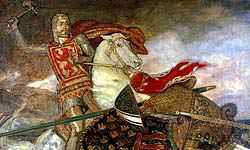
Historic Big cats in Scotland
 King Robert I (the Bruce) at Bannockburn in 1314
King Robert I (the Bruce) at Bannockburn in 1314
Big cats have been kept in Scotland for hundreds of years. The first known association of a big cat with the Royal family was King William 'the Lion' (reigned 1165 - 1214) who chose the Lion Rampant for the Scottish coat of arms in place of the previous Boar emblem. King William 'the Lion' was not alone in chosing a lion as his coat of arms, with King Vladislav II of Bohemia (1140 - 1172), King Alphonse of Leon (1188 - 1230), King Magnus VI of Norway (1263 - 1280) and King Magnus I of Sweden (1275 - 1290) chosing variations of the lion rampant, while King Cnut VI of Denmark (1182 - 1202) and King Richard 'the Lion Heart' of England (1188 - 1230) chose three leopards as their symbol.
However connections with cats can be found much earlier than the 12 th century. Before then, Alba, the Kingdom of the Picts, was divided into provinces - Fortrui (Strathearn), Fiobh (Fife) Fótla (Altholl), Círech (Angus and the Mearns), Cé (Mar and Buchan), Moireabh (Moray), Cataibh (Sutherland) and Gallaibh (Caithness). Cataibh was the land of the cat, and a tribe who may have been the ancestors of the Clan Chattan federation.
Cats have featured on Pictish symbol stones including the eighth century Calf Stone at Portmahomack, Easter Ross. This stone shows a calf being licked by a bull, with a cow behind. Above this pastoral scene there are more aggressive animal figures, including a lion-like creature. Is this beast a large wild cat, a mythical beast, or evidence that large cats were existed in Pictavia?
In Cat Country, Di Francis writes: "The first recorded evidence of big cats in Scotland can be found in the writings of sixteenth-century chronicler Ralph Holinshead, 'Lions we have had very many in the north parts of Scotland and those with manes of no less force than those of Mauretania; but how and when they were destroyed as yet I do not read' Just what animals Ralph Holinshed is referring to is unclear. Certainly Britain had lions way back in the ice age, but we would hardly expect Holinshed to know that in the sixteenth century. So is he eferring to creatures that have been known in modern times?"
The motto of the MacPhersons is "NA BEAN DO'N CHAT GUN LAMHAINN" - in English "Touch not the cat but a glove". The motto is a warning to those who would be so imprudent as to approach the wildcat (and by implication a MacPherson) when his claws are unsheathed or "ungloved".
There is evidence that the Kings of Scots kept lions from time to time with a Lyon's den at Stirling castle. It is also reported that David, first Duke of Rothesay and son of Robert III had a lioness as a pet.
Other noble families appear to have kept big cats as pets. At Dunnottar castle near Stonehaven, the home of the Keiths, the Earl Marischals of Scotland, there is a cave where a lion was kept. This animal escaped on at least one occasion.
Glasgow Zoo states "In 1823, the 10th Duke of Hamilton had a gardener's store converted to a den, with a run, for his Palace Leopard. The restored "Leopard House" can be seen as part of South Lanarkshire Council's Chatelherault Country Park."
There are also very old reports of big cats in England & Wales. For six centuries from 1252 there was a royal menagerie at the Tower of London until William IV closed the menageries and presented the animals to the Zoological Society of London.
George. Markie found the following whilst browsing the Country Life website
Chillington Hall, Staffordshire
Chillington Hall has been home to the Giffard family since 1178, when a Giffard was reputed to have killed an escaped panther, now depicted in the family crest.
There are also reports of the legend of Percival Cresacre, who fought with a giant wildcat (or 'wood cat') in Barnburgh near Doncaster, South Yorkshire, in 1475. Cresacre was ambushed by the cat in an area now known as Cat Hill, and struggled and fought with the cat until they reached the porch of St Peter's church in Barnburgh, and both died of their injuries. A red stain on the church doorway is said to be the blood of the evil cat.
Of course, the Black Dog (and similiar entities like Padfoot, Skryker and Barguest) may also be historical examples of what we now know as ABCs.
 |
 |
 |
| Return to index | Return to Scottish Big cats | Return to Why ABCs? |